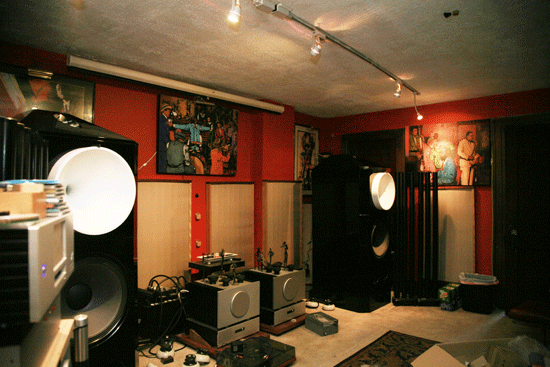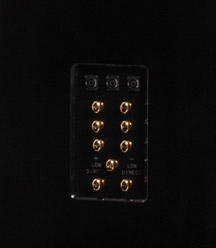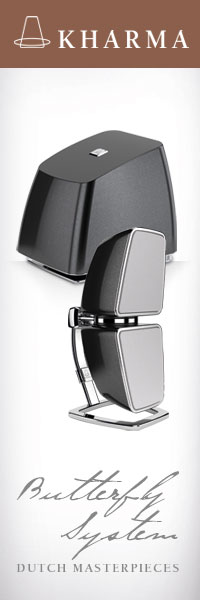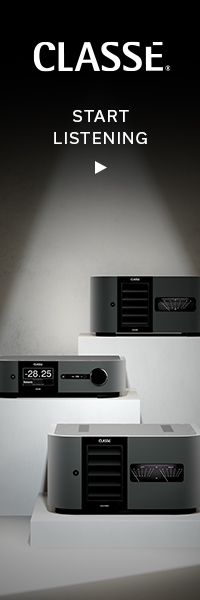Big. Bold and Beautiful
| Big, Bold and Beautiful |
|
|
|
January 2008 |

 At the 2007 Consumer Electronics Show, Sunny Cable Technology’s chief designer, Sunny Lo, invited me to their room to hear what he described as the best loudspeaker he could conceive. Being a fan of Lo’s cable designs and having been impressed by a number of his previous loudspeakers, I eagerly anticipated the performance of his new design. Upon hearing the Sunny Majestic, as the new loudspeaker is called, I was astonished in equal parts by its immense physical size and its sonic capabilities. It was clearly among the best loudspeakers I’ve ever heard, dynamic-wise. And that says plenty when you consider the sonic handicaps that must be overcome under less than ideal show conditions.
At the 2007 Consumer Electronics Show, Sunny Cable Technology’s chief designer, Sunny Lo, invited me to their room to hear what he described as the best loudspeaker he could conceive. Being a fan of Lo’s cable designs and having been impressed by a number of his previous loudspeakers, I eagerly anticipated the performance of his new design. Upon hearing the Sunny Majestic, as the new loudspeaker is called, I was astonished in equal parts by its immense physical size and its sonic capabilities. It was clearly among the best loudspeakers I’ve ever heard, dynamic-wise. And that says plenty when you consider the sonic handicaps that must be overcome under less than ideal show conditions.
Painted in high-gloss black piano finish and tipping the scales at 800 lbs per side, the Sunny Majestic has to be one of the biggest loudspeakers I’ve ever seen. The driver complement consists of a 16½” midrange horn and an 18” woofer, both featuring an ambient tweeter. This super-tweeter uses a very expensive magnesium diaphragm (noteworthy for its rigidity and low mass) and a frame machined from solid brass. It rolls on at around 18 kHz and is purported to go as high as 100 kHz. This gives the Sunny Majestic its two-and-a-half-way designation. The midrange compression driver has a 4” voice coil and a 4” diameter, low-mass, high-rigidity alloy diaphragm, driven by a powerful neodymium magnet. This driver, typical of horn-loaded designs, is very efficient with a sensitivity of 111 dB. It also has an exceptionally broad frequency range of 500 Hz to 20,000 Hz. The woofer has a frequency range of 20 Hz to 800 Hz and a sensitivity of 96 dB. It has a 4” voice coil and a magnet structure weighing 17 lbs! Overall sensitivity is rated at “96 dB to balance both dynamic and horn drivers evenly,” says Lo. The Sunny Majestic’s horn and woofer sections are built in separate enclosures, each weighing 400 lbs. If you’re guessing the driver assemblies could not possibly account for the humongous weight of this loudspeaker, you’re absolutely right.
Sunny Lo designed the immense weight of each enclosure to help quell resonances and reduce the colorations that have historically afflicted horn-loaded designs. The Sunny Majestic cabinet itself is made of medium-density fiberboard (MDF), varying in thickness from 1” to 3”, and employs copious amounts of glue, with no screws. Lo explained to me that “…screws have a resonant frequency that is in fact audible, and thus cannot be used.”
The Sunny Majestic’s horn was designed from the ground up by Sunny Lo because “…simply put, I couldn’t find the right horn for the type of sound I wanted.” According to Lo, his horn’s short throw or “throat” is ideal for near-field listening.

The rear of the Sunny Majestic loudspeaker features three sets of specially designed binding posts for tri-wire/tri-amplification capability. There are three external Speak-On connectors, wiring both the horn and bass enclosures, and using Sunny Cable’s unique ground and time alignment. Output adjustments for the super super-tweeter (4 dB) and midrange horn (3 dB) are available in ½ dB steps to facilitate smooth in-room response.
In retrospect (counting back nearly a decade), I’ve owned only four loudspeakers that I’d qualify as “reference caliber.” I report this because reviewers, in general, are unable, due to time constraints, to offer a full picture of what a component performs like over the long term.
Starting back in 1999 were the Talon Audio Khorus loudspeakers (which replaced my beloved VR6 from Albert Von Schweikert). They lasted until the winter of 2002. Then the German-made Ascendo System Z and M loudspeakers graced my listening room for almost three years, before the mighty Dali Megalines displaced them in the summer of 2005. Composed of 12 individual mid/bass drivers and a nearly 8-foot-tall dipole ribbon tweeter, this elegantly designed transducer produced state-of-the-art sound that was immediately addictive. I anticipated a life of sonic bliss with the Megalines. That is, until I heard the Sunny Cable Technology Majestics.
This is the first horn loudspeaker to have graced my listening room. I have genuine admiration for ribbons and line sources, but the finest audio system I’d ever heard, BAR NONE, was an all-horn system in 2004. This system in southern France belongs to Jean Yves Kerbret, a well-known (and super-rich) audiophile, whose system showed me what is possible when TLC (Tweaking & Loving Care) and money’s no object.
What I heard there forever changed my opinion of horns.
This five-way speaker system utilized Tact digital crossovers and modified Tact electronics throughout, conveying an ease and purity unheard of to my ears. The sense of rightness of instrumental timbre, harmonics, and the remarkable sense of scale sounded more lifelike than anything I had heard before. Unfortunately, the cost of the loudspeakers alone was about $300,000. Most interesting was that this system was not tube-driven, but entirely digital. Surprisingly, the Tact gear chosen had recently replaced a bevy of very expensive tube amplifiers that appeared to be the logical choice for such high-efficiency transducers.
Even after purchasing the wonderful Dali Megalines, utilizing Ralf Ballman’s sophisticated digital crossover circuitry and room correction, as designed in his Behold preamp, and adding dedicated Sunny Cable subwoofers to help address the Megalines’ inadequate low-end, my system still didn’t come close to the sound I heard in France. The question arose with every upgrade, and the answer was always the same: “No, this is not up to the caliber of sound in Jean Yves’ setup.” For the life of me, I couldn’t figure out what was wanting in my system, but, to reiterate, I had never owned horns and was not aware of what they could do.
For the next six months after the 2007 CES, Sunny Lo would ask if I were interested in reviewing the Majestics, and my answer was always the same: No, thank you, I’ll pass. First of all, despite their sonic attributes, the Sunny Majestic loudspeakers are incredibly big and impractical. Anticipating getting them up two flights of a winding staircase into my third-floor listening room seemed nearly impossible, if not flat-out crazy. For six months, I remained somewhat sane and was as content as possible.
Then the idea arose to build a smaller version of the Majestic, lighter in weight and utilizing smaller drivers (photo on the left). Lo agreed, but warned it would not be the sonic equivalent of a full-size loudspeaker. At first I agreed, but then I thought, No, I wouldn’t want to settle for anything less than what I’d heard at the show. Standing 72” high, 33” deep, and 26” wide gives the Sunny Majestic loudspeaker quite a footprint. Measurements were taken of both my front door and the one leading to my upstairs listening room (which measured a very tight 27”). Then, I contacted a local piano moving company that would be available on the tentative arrival date. How on earth did I go from “No thank you, I’ll pass” to “Okay, I’ve got piano movers ready?” Sunny Lo reassured me that I would not regret it. Meanwhile, my conscience said otherwise.
Long story short, upon their arrival, they were making it up to my listening room in all of 14 hours. Two piano moving companies had to apologize for NOT being able to break down four heavy pallets and get their contents up my two flights of stairs and into my dedicated listening room. Ultimately, I hired two guys from the neighborhood (who I believe are direct descendants of the same folks who built Stonehenge). These two locals did what a dozen certified piano movers could not. In fact, they made it look easy, and wanted to hear them after they were set up. (I had to ask them back some weeks later, after fine-tuning and burn-in).
Preference versus Performance
Upon initial setup, I found that the Sunny Majestic loudspeakers were sonically more capable and more truthful to the music than the Dali Megalines. Duly noted, the Dali Megalines remained the more musical…at least for about another two weeks. I knew the musicality would come to the Sunny Majestics in time, but not without proper burn-in, patience, and the delicate re-tuning to my listening space. After one month of intense listening and evaluation, I was convinced that the Sunny Cable Majestic loudspeaker was among the best I had ever had the pleasure of hearing, and certainly one to live with.
In fact, the sound of the Sunny Cable Majestic loudspeakers (or more appropriately, the lack thereof) has challenged everything I thought I knew about loudspeaker theory, especially my preference for ribbons and line-source designs.
The Sunny Majestic loudspeakers possess the most accurate sense of musical rightness and detail retrieval I’ve heard in my listening space. Initially, the ability to listen this deeply into almost any recording proved both startling and disconcerting. Wynton Marsalis’ early career works, like the excellent Black Codes (from the underground), showed me exactly what I had been missing previously. The heightened sense of macro- and micro-dynamics, the drama behind and ultra-quiet space, along with a liquid ebb and flow, had finally been revealed and understood. So much, it made familiar tunes almost unfamiliar. Marsalis’ trumpet sounded as if it was being recorded from a place further away than what I remembered through the Megalines. The recording venue seemed bigger and more clearly delineated, as if the studio had been widened and made more reverberant. Horns had an obvious sense of utter ease. A major attribute of the Dali Megalines is their sense of ease and scale, especially on big band or symphonic works. However, even those great features could not compare to the effortless sound quality of the Sunny Majestic loudspeakers. The Megalines make a system sound like it’s not being played hard, while the Sunny Majestics, which, if not careful, will peak effortlessly over 100 dB, sound like they’re not even on. The ability of the Majestic loudspeakers to differentiate separate instruments playing simultaneously is unsurpassed in my listening experience. This may serve as news to me now, but I’ve been forewarned about these dynamic contrasts for years by horn aficionados.
Nothing is more illustrative of this than the beautifully sung “River” featuring Corinne Bailey Rae from Herbie Hancock’s latest CD entitled River: The Joni Letters. Rae’s saccharine sweet voice, contrasted with Wayne Shorter’s soft and floating improvisational riffs, along with Hancock’s amazingly poetic interplay, serves up a refreshingly new twist to the term jazz collaboration. The Sunny Majestic loudspeakers transformed this CD closer to live than any other loudspeaker I’ve had in-house.
What I think gives the Sunny Majestic this unique advantage isn’t its inherently truer tonal shadings because it’s a horn, or that horns are unbelievably transparent. Surely all these things matter, but I believe the Dali Megalines possessed similar strengths as well. What the Sunny Majestic loudspeakers have that qualifies them as a rarity, is their ability to convey proper dynamic contrasts in the bass—the midbass in particular.
Using the same source components in the Behold electronics and Nova Physics Memory Player, it became clear some pertinent observations in regard to loudspeaker design and setup:
1) Bass drivers and their enclosures should be as close as possible to the mid and high frequency drivers for proper time alignment.
2) Large cabinet size, high mass, and rigidity have huge advantages over smaller, lighter-weight designs.
3) Size matters. When the aforementioned are achieved with neither size limitations or financial constraints, only then can a speaker system possess some of the most powerful, fastest and responsive bass possible—especially when coupled to a horn.
Case in point: No matter how much better the bass became using after market dedicated subwoofers with the Megalines—Talon Thunderbirds and an excellent pair designed by Sunny Lo—the quality of the bass never approached what I am getting from the Sunny Majestic loudspeakers.
Contusions and Conclusions
In the end, the Sunny Majestic loudspeakers leave nothing to be desired. It does more under one roof than any loudspeakers I’ve heard (except for Jean-Yves’s tremendous setup, which features $300,000 loudspeakers). At $90,000, I would call the Sunny Majestic a comparative bargain, albeit an impractical one at 800 lbs per side.
Most importantly, my personal convictions and preconceived notions have undergone significant changes since the arrival of the Majestic loudspeakers. It is, after all, a horn, and I believe the ideal loudspeaker manufactured in the here and now — based solely on what I’ve heard over the past three months here, and of course my experiences abroad — would certainly have me pointing to a horn-based system. Our own Greg Petan has just received a newer and somewhat smaller version of the Sunny Majestic that weighs only 550 lbs per side and has 15” woofers. I think he’s a new convert, too. You can include Dennis Parham in that equation since he reviewed the smaller baby brother of the Majestics back in the fall.
The way this particular horn loudspeaker electrifies the air with its intrinsically low distortion, coupled with an immense sense of scale and a high-frequency purity that’s like spring water, takes this listener closer to the music than any dynamic, electrostatic, or anything in between has done. From here on in, I’m hanging my hat on a horn… a Sunny Majestic horn to be exact.


clement perry
#####
Loudspeaker Model: Majestic
Description: 3-Way system with bass reflex woofer and horn-loaded mid and high frequency drivers.
Frequency Response: 20 to 100,000 Hz
Sensitivity: 96 dB
Power Handling: 450 W program
Impedance: 8 ohms
Mid-Range Horn: 16.5” (42 cm) and weighing 77 lbs (35 Kg). Original design with innovative material.
Mid-Range Driver: Compression driver with 4” voice coil, 101.6 mm diaphragm, neodymium magnet, 2” exit.
High Freq. Driver: Horn supertweeter, magnesium diaphragm, alnico magnet.
Woofer: 18” bass reflect design. 4” voice coil. 450 watts of power handling capability.
Crossover: Special design using the best commercially available components known for their fast speed and
long-term reliability. Unique design to balance the speed among drivers. Fully shielded and
grounded.
Adjustments: Supertweeter: 4 dB levels in 8 steps.
Mid-Range: 3 dB levels in 6 steps.
Internal Wiring: Patent pending, Time-Accurate cable design. Fully shielded and grounded.
Binding Posts: 7 tota,l including one for grounding. Twi-wire and tri-amp connections possible. Unique design
using the posts as clips only and not for conducting. Conductors are brought to the outside for
direct contact with speaker wire terminals. Binding posts are extra large, widely spaced for ease
of connecting, and gold plated for beauty and durability.
Cabinet: Highest quality MDF with thickness ranging from 1” to 3”. 3-piece modular design: mid and
high frequency units secured together as one, the woofer unit and the base plate as the other two.
Finish: Black piano finish on all six sides.
Dimensions: Overall 74” H x 26” W x 29” D. (188 cm H x 66 cm W x 74 cm D)
Weight: Approx. 900 lbs.
Introductory Price: USA $88,000 a pair.
Made in U.S.A.
Sunny Cable Technology
Fi r s t in s ignal accuracy!
PMB 238, 21c Orinda Way, Orinda,
CA 94563, U.S.A.
Tel: (925) 258-3688
Fax: (925) 258-9862
www.SunnyCable.com
Stereo Times Masthead
Publisher/Founder
Clement Perry
Editor
Dave Thomas
Senior Editors
Frank Alles, Mike Girardi, Russell Lichter, Terry London, Moreno Mitchell, Paul Szabady, Bill Wells, Mike Wright, and Stephen Yan,
Current Contributors
David Abramson, Tim Barrall, Dave Allison, Ron Cook, Lewis Dardick, John Hoffman, Dan Secula, Don Shaulis, Greg Simmons, Eric Teh, Greg Voth, Richard Willie, Ed Van Winkle, Rob Dockery, Richard Doron, and Daveed Turek
Site Management Clement Perry
Ad Designer: Martin Perry





Be the first to comment on: Big. Bold and Beautiful